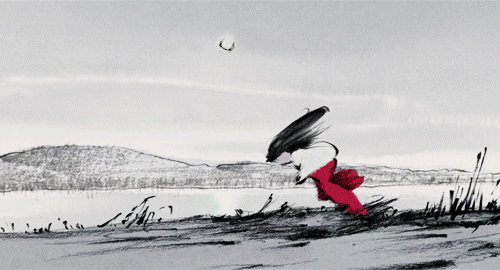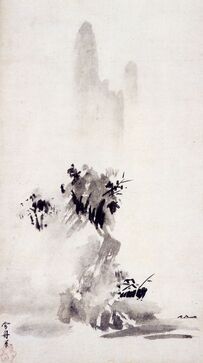 Princess Kaguya, a young woman adopted by an old bamboo cutter and his wife, grew up in the country among the peasantry until her father deemed it wise to take her to the capitol to be raised as a lady. While being quite uncomfortable and unhappy there, Kaguya managed to flourish and not break down in frustration. During her coming of age ceremony, however, she overhears some drunken men mocking her father for trying to make her into a noblewoman. This is too much and she flees from the mansion and off into the countryside.  The animation here changes distinctly from the previous gentle ink style, becoming wild, desperate, and quick making it almost impossible to distinguish figures from landscape. This sudden switch seems to reference a style of ink painting that was introduced to Japan from China during the Muromachi (Ashiga) period (1392-1573 CE) known as haboku (“broken ink”) painting. This style, based off of the Chinese Song dynasty style of the same time, was rooted in Chan (or Zen in Japan) Buddhism and embraced spiritual inspiration and spontaneity. This is clearly seen in a work such as Haboku Landscape for Soen by Sesshu Toyo, which is an incredibly simple, yet deeply expressive work. The ink tones vary beautifully, creating a vague impression of a small island with huge rock pinnacles behind, almost as if it is being seen through a mist. According to the book Art Beyond the West: "Painters working in this style believed there were traces of spiritual inspiration to be found in the accidental and spontaneous patterns formed by ink splashed onto the paper in this way. In [the painting], Sesshu uses very loose brushwork, yet by creating sharp tonal contrasts through a variety of washed and strokes, through a few carefully placed marks, he is able to capture the spirit of an entire landscape with its rocks, mists, and deep spaces. Although careful analysis might reveal how each mark contributes to the representation, the picture is not the product of any kind of premeditated calculation of this sort" (P. 171, Chapter 5). This spontaneous and abstract approach to representation fits perfectly (and devastatingly) into the scene in Kaguya, which later turns out to have been a dream. The emotion and desperation, while not the original intent of the painting style, is clearly visible when used in a storytelling context and with the added touch of animation, it reaches another level of movement very literally. While this style does not match the time period Kaguya is set in, it brings in some important stylistic qualities of Japanese paintings and aesthetics. - Bee
0 Comments
|
AuthorEach of the Silverfists take turns sharing their thoughts about illustration found in graphic novels, games, album art, and more... Archives
October 2023
Categories |

 RSS Feed
RSS Feed